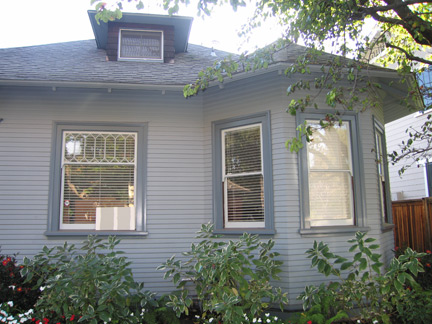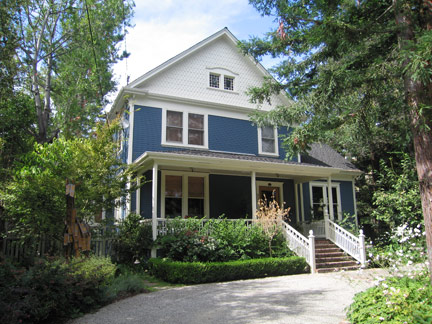 Palo Alto Stanford Heritage
Palo Alto Stanford Heritage 2006 Holiday House Tour:
Preserving, Presenting and Celebrating Historic ProfessorvilleShortly after Palo Alto was opened for development, several of Stanford University’s first faculty members began to build houses in this section of the new town. Since the area was noticeably set apart from the other populated district around University Avenue, it became known as “Professorville.” Stanford’s policy of granting only an 80-year lease on university land, rather than outright ownership for residents, was a compelling reason for some faculty people to build in town, and this location provided easy access to the campus via Embarcadero.
Professorville is listed on the National Register of Historic Places.
Homes on the tour:
367 Addison Avenue — more
940 Bryant Street — more
959 Waverley Street — more
331 Lincoln Avenue — more
1037 Ramona Street — more
1027 Emerson Street — more
Built in 1905 and originally the home of Dr. John Spencer, the first mayor of Palo Alto, the legendary Hewlett–Packard garage and house underwent a painstaking and thoughtful restoration by the company in 2005 to return them to their 1930s condition after years of alterations. The furnishings are also of the period when the company’s founders lived and worked there.
Take a step back in time as you stand by the fireplace mantel. Here, in 1938, Bill Hewlett and Dave Packard first brought the prototype for their oscillator inside, placed it on the mantel, and took a picture of it. Venture into the adjoining room where Lucile Packard then typed up specifications at the dining room table, and you have HP’s first mailing to prospective customers. Each night, the Packards would move the dining room table, pull down the Murphy bed, and make their sleeping quarters. The painted panels for the oscillators were baked in the oven of the Wedgwood stove in the kitchen. Bill lived in the sparsely furnished rustic shed, which was fine with him. He was focused on his work.
The simple 12 x 18–foot garage is where it all started. This was HP’s first workshop and manufacturing facility. It was here that they developed their first product, the resistance tuned audio–oscillator, which was named Model 200A, so it would sound like the company had been around for a while.
The garage itself is an example of true preservation. The design and materials are unchanged except for measures necessary to save it for the future. The structure was raised up six inches on a new concrete sill and received a steel frame, but the wall boards were numbered and re–used. The project architect was Monty Anderson of Cody Anderson Wasney Architects, Palo Alto.
There’s an interesting story behind this vernacular cottage with clapboard siding, brackets under the eaves, and an unusual six–sided bay. The house was constructed in 1901 by a local builder, H. L. Upham. He sold the cottage to Mrs. J. W. Kelly, a widow, in 1902 for $1,500. Daughter Alice Kelly was deputy postmaster for Palo Alto from 1892 to 1906, when she relinquished her postal career to become a serious student of photography. The house next door at 944 Bryant was built as a photography studio for Alice. The studio remained an active business until 1940, and the Kelly family owned the cottage until 1961.
The present owners bought the house not quite three years ago and have extensively updated it, while at the same time being respectful of its vintage.
The interior is a lovely blend of new and old. The redwood beams in the living room are original, but the crown molding and mahogany flooring are new. The original redwood beams, doors, baseboards, and benches were retained throughout the house, and are enhanced by new flooring, crown molding, and art glass.
The original pantry was incorporated into the kitchen and the wall which separated the kitchen from the living room was replaced with a counter and hanging cabinets, to create an open feeling. The design was by Kristen Harrison and construction by R.J. Smith.

Built in 1904 for D. C. Dibble by W. F. Hanrahan in a simplified Queen Anne style, the house features a front gable with clipped shingles and a louver vent. The side gables have an unusual treatment of projecting vertical boards closely spaced and resting on modillions. The porch was partially enclosed, perhaps in the 1920s, but the details are original, including the wonderfully decorative front door.
From 1914–16 this was the home of Edith Mirrielees, distinguished professor of English and Creative Writing at Stanford. When she died suddenly just weeks before her book, Stanford, the Story of a University, was to be published, Wallace Stegner, her close friend and colleague, composed a loving tribute which was placed inside the front cover. You’ll find a copy on the dining room table.
The current owner has adapted the interior to fit her needs, always while keeping in mind the historic style and feel of the house. Storage has been created throughout the house by tucking cabinets and shelves into previously unused areas. China closet doors from the dining room were reused in the upstairs bath, and the sink was mounted in an old desk.
The owner’s effort to keep alterations sympathetic to the period of the house is truly evident in the kitchen. Instead of a modern island, there is a pine table made from old flooring. The sink sits in another table. The hood over the O’Keefe & Merritt stove was designed to be reminiscent of an English kitchen hearth. The microwave is behind the curtain. A former PAST Heritage board member, Laura Ferrell, owner of Woodenwings Builders, Inc., was the contractor for the remodel.
In 1893, a year before Palo Alto was incorporated, this handsome Queen Anne house was built for $2,300. The present owners restored the original house and replaced a rear addition from the 1960s meticulously repeating the historic elements in the new portion. The result is an exciting artistic environment which fulfills the needs of a family with four children.
The most notable features of this simplified Queen Anne house are in the front gable. The shingles are unusual—almost fish scale, but not quite. An eyebrow pediment is above the pair of windows, which are outlined with colored glass. The original porch balustrade was replicated based on a photograph taken in 1900. The architect for the restoration and addition, Aino Vieira da Rosa, a PAST Heritage board member, repeated that gable on the new rear elevation.
All of the doors on the first floor are new, but are close copies of the original doors, all of which are now on the second floor. All of the hardware is old, but not all is original to this house. The pocket doors between the living and dining rooms are original, as is the fireplace in the dining room.
The new section of the house blends with the original because elements of the Queen Anne style continue. The transoms over the kitchen eating area echo those above the doors on the second floor and the pocket doors between the kitchen and family room are like those between the living room and dining room. The mantel over the fireplace in the family room was recycled from a fireplace that was removed from the den at the front of the house.

Fortunately for this Colonial Revival house, its new owners relished doing extensive research to ensure that their alterations and furnishings were in keeping with the age and style of the house.
The house was built in the Colonial Revival style in 1906. Originally, it had a low hipped roof with two attic dormers, but in 1979 the hip roof was replaced with a steeply pitched gable to make space for two bedrooms and a bath on the second floor. Recently, the present owners removed the modern window and reworked the entire gable to make it compatible with the rest of the facade. Monty Anderson of Cody Anderson Wasney Architects was the architect. The front door was centered in the 1940s, and the present owners installed the lovely leaded glass. The decorative frieze was an addition at some point.
The handsome mantel and tiles of the fireplace were brought from England. Along with the Art Nouveau fixtures gracing the mantel, they refer back to the turn of the 20th century.
The living room ceiling fixture is Victorian, and those in the dining room are from a theater in Paris.
The lovely brass hardware in the den is original, but the patterned ribbon glass in the window and the hand-painted wallpaper by Paul Duchscherer were the result of research and treasure hunts by the present owners. Perhaps as a “thank-you” from a grateful house, an attic wall yielded the original plans for the house, which are now framed and hanging in the hall.
Another home with a connection to the electronics industry of Silicon Valley is this 1899 Craftsman house. William Shockley, who received a 1956 Nobel Prize in physics as coinventor of the transistor, lived here as a child from 1914–1922. The new owner received a much deserved award for “meticulous restoration” of this house, at the 11th Annual PAST Heritage Preservation Award Ceremony last May. He said, “Everything in the house was original, was purchased from another Craftsman house, or was made in the Craftsman style especially for this house.”
The entry hall, living room, and dining room have been refurbished, but are unchanged. Still, authenticity did not preclude the latest in technology—concealed in the hall closet. Visible is the 1930s vintage telephone, which retains its old ring, but has new innards.
Upstairs, changing a bedroom into a bathroom was complicated by the windows. In order to leave the exterior unaltered and still achieve privacy, art glass designed by Donna Hunt was installed. The tub is original, but the feet were re-plated, and the sink was brought from Spain. In the front bedroom, note the period squirrel cage bulbs in the ceiling fixture from France. In the office, note the photo of William Shockley, taken in this very room.
The master bedroom suite is in the new section of the house. The 1906 two–story addition was completely rebuilt, as you can see by the change in the flooring from fir to cherry. The old windows were reused and, as you might guess, this was originally a sleeping porch. Downstairs, in the living room, the fireplace is original. Since there is no space between the ceiling and the floor above, the new wiring is hidden in a chase or runway along one beam. The Stickley furniture and furnishings are from Flegels.
All the old interior walls of the kitchen, which is in the rebuilt addition, were removed, creating one great room. The handsome cabinets were made locally by Bob Tupper, and the stained glass was made by a company in Ohio. The dishwasher is behind the set of four drawers, and the farmer’s sink is set into a soapstone counter to give the new kitchen an old feeling. The period light fixture over the island has a counterweight to allow the relatively dim light of that time to be brought closer to the task.
| |
E-mail us at either webmaster@pastheritage.org or president@pastheritage.org.
![]() Palo Alto Stanford Heritage—Dedicated to the preservation of Palo Alto's historic buildings.
Palo Alto Stanford Heritage—Dedicated to the preservation of Palo Alto's historic buildings.
Copyright © 2015 Palo Alto Stanford Heritage. All rights reserved.